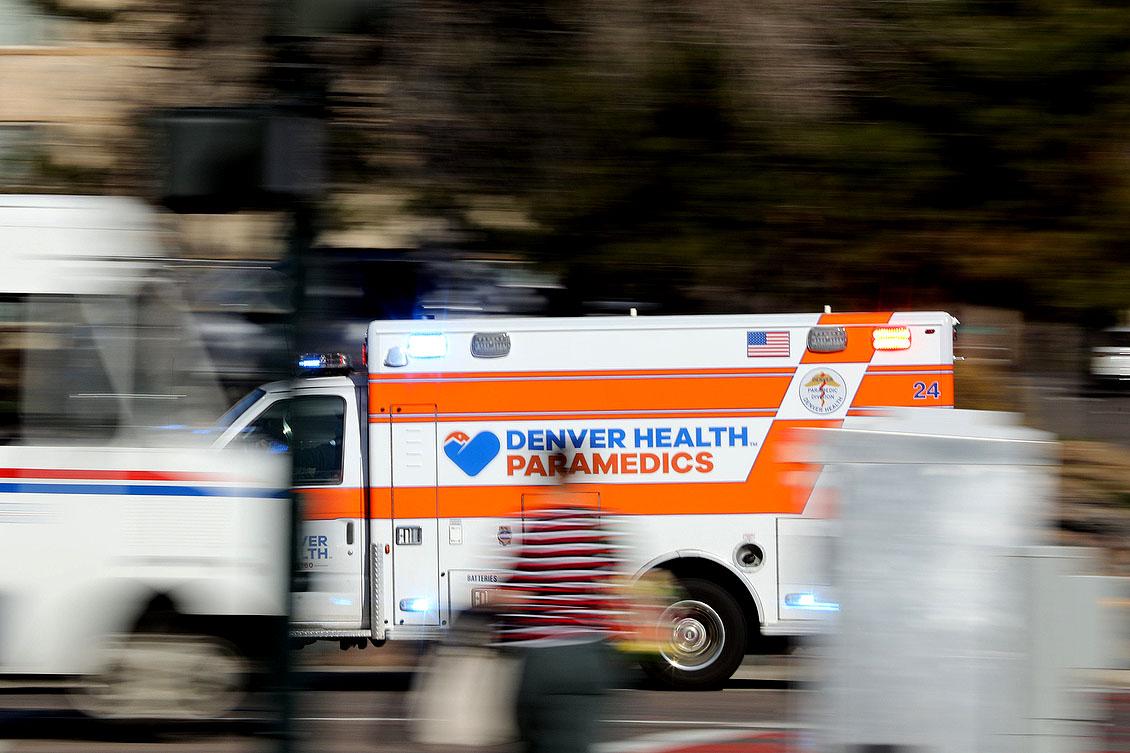
Colorado’s COVID-19 situation is worsening. The latest sign, not unlike the red flashing lights and sirens of an ambulance, came late Friday afternoon when the state reactivated its emergency standards, called crisis standards of care, for emergency medical services. It’s the first time the state has done that for EMS since the pandemic took off in April 2020.
Still, the state’s top medical officer is urging those who are sick or in need of emergency care to use 911 or seek emergency care as normal.
The state health department said it issued the guidance on how best to use EMS services because a lot of staff are out sick and due to “high demands for patient transports.”
What the standards mean for patients
The state’s EMS crisis standard plan allows agencies to override normal operating procedures to essentially prioritize and triage care, depending on the resources — paramedics and ambulances for example — available.
For patients, it means transport might happen in “only the most severe cases,” and where an ambulance will take a patient for care could include clinics, surgery centers, urgent care centers, or other alternate sites in addition to hospitals. Or that crews could consider not transporting patients under 60 years old.
For EMS agencies, it means allowing them options like changing the configuration of staff and crews, “i.e. one EMS certified or licensed provider and one non-medical driver.”
For dispatch centers, it might mean not sending an ambulance if there’s “no life-threatening symptoms (chest pain, difficulty breathing, altered mental status) present” in order to reduce the chance of a first responder being exposed to COVID-19. They could also save some resources for “severely ill or injured patients” and other patients would be directed to “nurse advice lines, telehealth or mobile integrated health services.”
“As there are less ambulance crews on the streets, because there are simply not enough people to work because they're out with COVID, if somebody calls 9-1-1, the trained medical dispatchers have the ability to ask a number of questions and determine if an ambulance should be sent,” said Scott Bookman, the state’s COVID-19 Incident Commander, himself of former chief paramedic in Denver. “This is really a tool to ensure that our EMS providers are able to provide care to those who need it most in a time of workforce shortage.”
Bookman said if they do determine that the ambulance should be sent when the crew arrives, the EMS crew medical can assess the patient and if they are low acuity, “maybe they give them some instructions to follow up with their doctor, go to an urgent care or self-transport themselves to the emergency room.”
He said that will help “keep those 9-1-1 ambulances in service for the more acute calls, the heart attacks, the strokes, that require that level of care.”
“This is about staffing,” Bookman said. The change “allows us to be sure that these limited health care workers that we have are able to do the most important work they can do.”
Cases and hospitalizations are up since Christmas Day
The Polis administration has to date ruled out some other statewide measures, most prominently a statewide indoor mask mandate. Gov. Jared Polis told CPR’s Colorado Matters last month he would leave mask mandates to local officials, saying the state shouldn’t “tell people what to wear.” The comments came after nurse and doctor’s groups, hospitals and public health officials, among others, urged the step as a means of limiting transmission.
The EMS crisis standards reactivation comes as the omicron variant is fueling an unprecedented wave of coronavirus cases, in Colorado and nationally, and hospitalizations continue to climb. Public health officials have put out the call for residents to stay up to date on COVID-19 vaccines to ease the strain on the already heavily taxed health care system
On Friday, the state health department reported 1,374 people hospitalized with confirmed cases. That's up nearly 400 in the two weeks since Christmas Day.
And staffing is dangerously thin. Fifty-three percent of hospitals say they anticipate a staffing shortage in the next week. A third say they anticipate a shortage of intensive care beds.
“Things are very busy across the board, everywhere from the emergency department, all the way through, into the intensive care unit,” said Dr. Anuj Mehta, a pulmonary critical care physician with Denver Health. He said the surge is coming from a combination of an increase in the number of patients arriving at the emergency room, more patients being admitted to the hospital and much more severe staffing shortages.
The seven-day average of tests coming back positive is nearly 27 percent, the highest level documented during the entire pandemic. Just three weeks ago, it was around 6 percent.
“Your health in an emergency is always a priority. The dispatchers and emergency medical service experts will help you determine if you need immediate care,” said Dr. Eric France, the state’s chief medical officer, in a statement. He said they may also advise a patient to seek care through a normal doctor’s appointment if it can wait.
“With increasing demands on hospitals and EMS, we need to make sure we can provide care to anyone who needs it immediately. Crisis standards of care help us to do that,” he said. He also urged every Coloradan older than 5 to get vaccinated so we can “lessen the strain on our health care system and protect everyone.”
According to the health department, the crisis standards for Emergency Medical Services provide guidance for call centers, dispatch centers, and emergency medical service agencies, and responders regarding how to interact with potentially infectious patients and maximize care for multiple patients with limited staff and emergency vehicles. The guidelines also help with the mapping out of what kind of treatment to provide, such as whether and where a patient should be transported for further care, if necessary.
The state of Colorado reactivated crisis standards of care for staffing of health care systems in November. Those standards allow hospitals to carry out staffing solutions to meet the increasing medical needs of their communities.
“We're seeing more and more health care workers testing positive for COVID-19 with the omicron wave,” Mehta said. “Luckily the vast majority of them are relatively either mild asymptomatic or asymptomatic. That's a saving grace is that they're still, you know, returning to work after five days, but things are very busy.”
The state has not currently activated some of its crisis standards of care, like those for hospital and acute care facilities, out of hospital care providers, specialty patient populations, or personal protective equipment (PPE).
Crisis Standards of Care are protocols that help health providers and systems to determine how to deliver the best care possible under extraordinary circumstances stemming from a disaster or public health emergency. They can be used when there are not enough resources to provide the usual standard of care to people who need it. The goal is to care for as many patients as possible and save as many lives as possible, according to the state health department.








